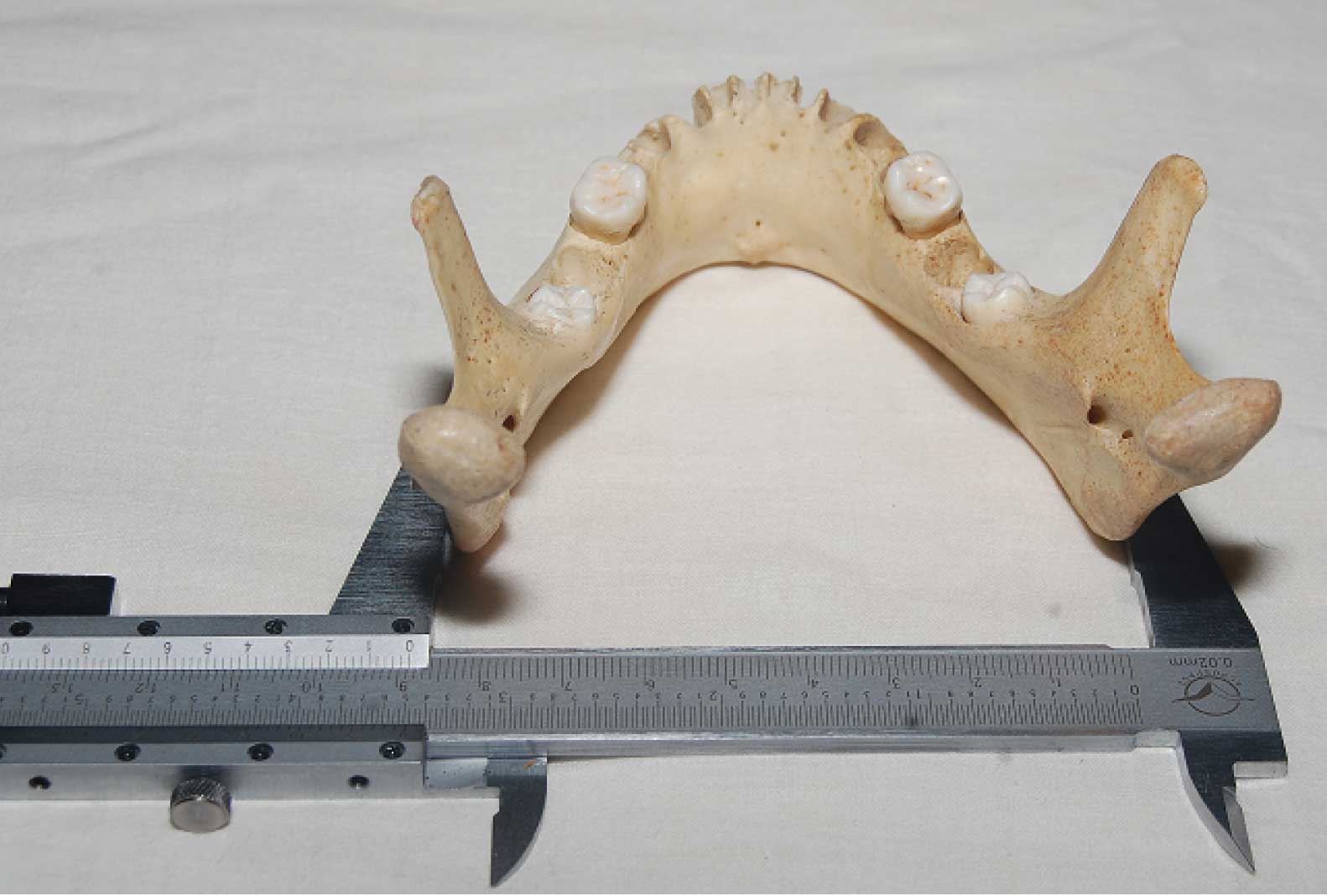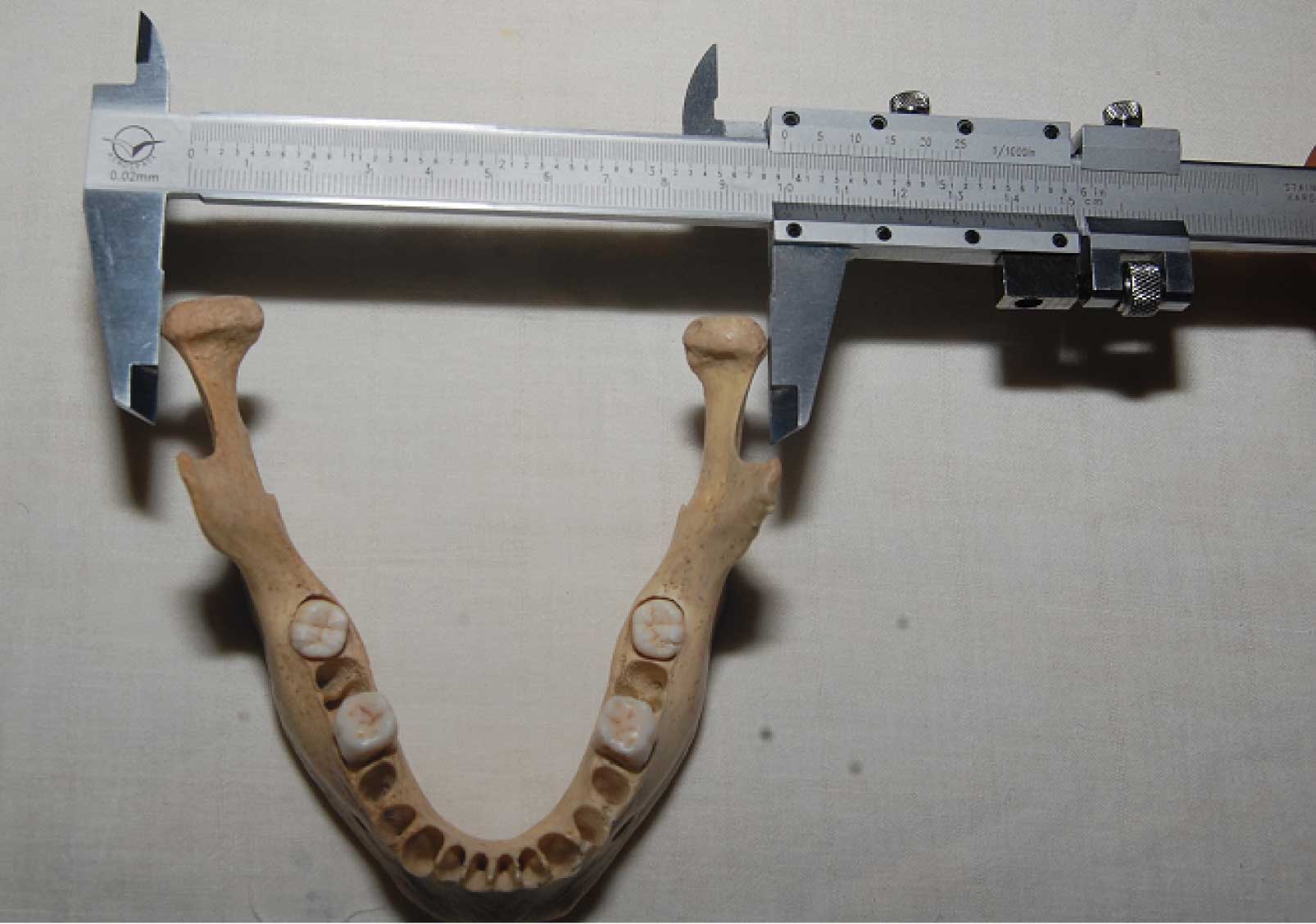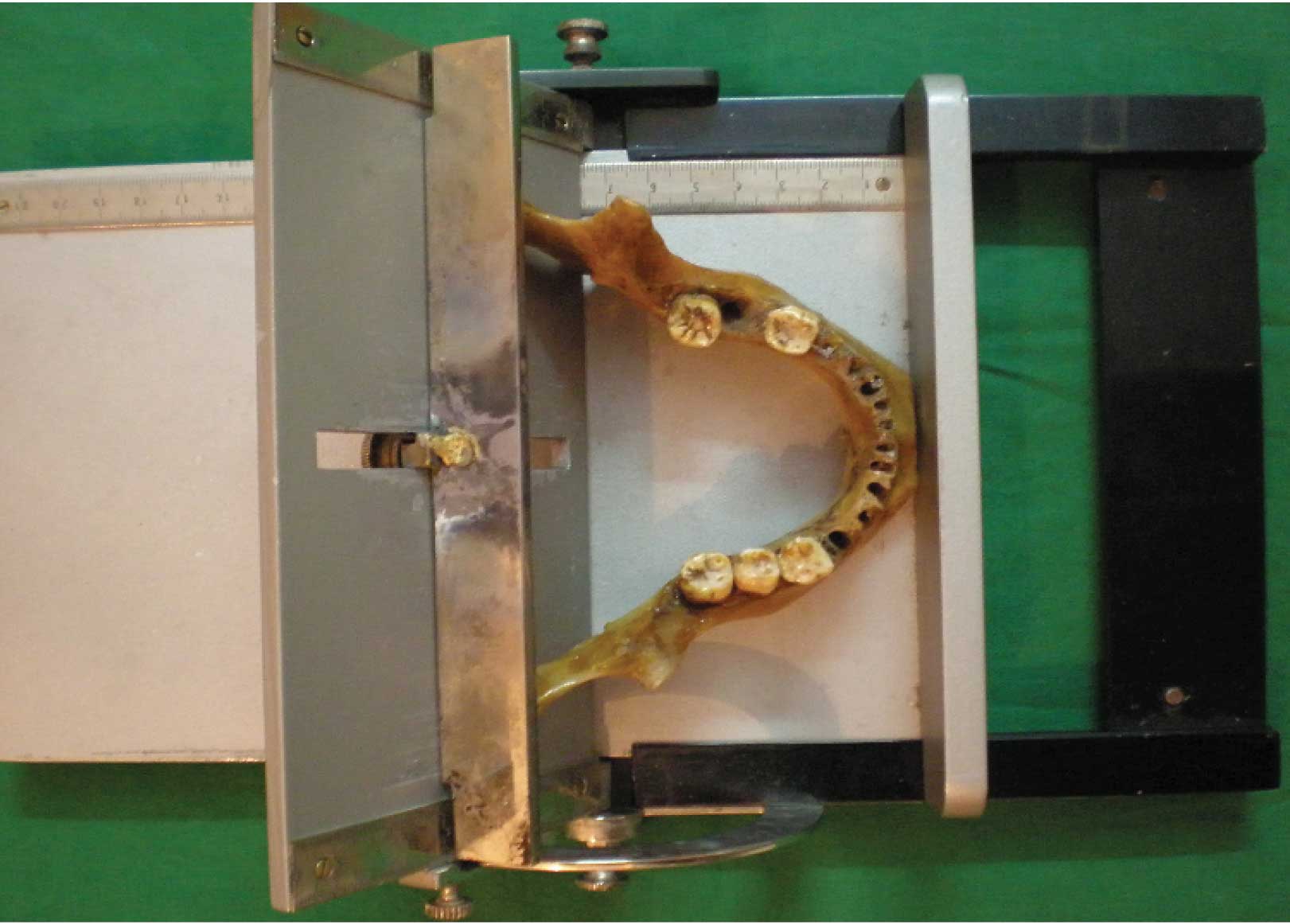Introduction: Determination of sex from an unknown human bone is an important role in forensic and anthropology field. The mandible is the largest and hardest facial bone, that commonly resist post mortem damage and forms an important source of information about sexual dimorphism.
Aim: To determine the sex of unknown human adult mandible using metrical parameters.
Material and Methods: A random collection of 250 dry, complete, undamaged human adult mandibles of South Indian population were subjected to metrical parameters like Bigonial breadth, Bicondylar breadth and Mandibular length using Mandibulometer and Vernier caliper.
Statistical Analysis Used: The data’s were expressed as Mean ± SD and then analyzed by t-test by using SPSS software. Discriminating point and limiting points were also calculated.
Results: The mandibular length, bigonial breadth and bicondylar breadth showed significant statistical gender difference.
Conclusion: The present study revealed that the sex of human mandible can be assessed by using metrical parameters as an additional tool to establish the identity of a person.
Introduction
Sex determination of bone is a very important part of study in Anthropology and Forensic science, as further interpretations and analysis will be based on it. Normally morphological and metric methods are used to determine the sex of a bone. The advantage of metric analysis is that obtained data can be easily comparable with the other studies [1]. Sex of an unknown individual can be determined based on the data from the morphology and metric features of skull and mandible, soft tissues, forensic odontology, as well as by DNA analysis of teeth [2].
Among human bones, the pelvis and skull are the most reliable source for sex determination. In absence of complete pelvis, then mandible becomes important source for sex confirmation. The mandible is the most durable facial bone that retains its shape better than others [3]. Mandible is the strongest and movable part of the skull [4] and forms the chief articulating segment of skull. Its morphological features show changes with reference to age, sex and race. It is the platform for dental surgeons to work with [5].
In explosions, warfare, aircraft crashes and earthquake disasters, identification and sex determination of victim is generally established by dental records. When dental records are non-existent or unavailable, sex determination of unknown mandibles are carried out by the usual methods of size, muscular markings become unreliable [6]. Male and female mandibles are distinguished by general size, chin shape, gonial angle and gonial flare [7].
Loth and Henneberg [8] observed a distinct angulation at the posterior border of male mandibular ramus at the level of occlusal plane. In most females, the ramus retained its straight juvenile shape [9].The use of mandibular ramus flexure as a method to distinguish between genders was observed by Loth and Henneberg and were reaffirmed by the study of Koski, 1996; Indryana et al., Donnely et al., Hill 2000.
Many attempts have been done on osteometric and morphological features to differentiate between male and female, such as studies of indigenous, white and black South Africans [10–12,8] and Koreans [3]. These reports emphasized the necessity for population specific standards. Till date, the standard determination of sex from mandibles in South Indian population, using metric analysis has not been reported.
Material and Methods
After obtaining institutional ethical committee clearance, 250 adult dry, complete, undamaged human mandibles were collected from various medical colleges in-and around Bangalore and Puducherry, (India) for parametric analysis using the vernier caliper and mandibulometer. Only well-formed adult mandibles without any deformity were subjected for the study.
Bigonial breadth is the straight distance between two gonia [Table/Fig-1].
Bigonial breadth measured using vernier caliper

Bicondylar breadth is the straight distance between the most lateral points on the two condyles [Table/Fig-2].
Bicondylar breadth measured using vernier caliper

Mandibular length is the distance of anterior margin of the chin from a centre point on a projected straight line placed along the posterior border of two mandibular angles [Table/Fig-3].

Mandibular length measured using mandibulometer

Results
Out of 250 mandibles collected from medical institutions in and around Bangalore and Puducherry, India, 175 male and 75 female mandibles were categorized on the basis of morphological features. The parametric data were recorded and the mean and standard deviation were derived.
Statistical Analysis
The values were analyzed by student t-test using SPSS software (version 17.0.1).
Bigonial Breadth
The demarking point of bigonial breadth for male was 10.35 and for female were 7.8. Limiting point for bigonial breadth was 9.1, applying this limit about 75.92% of male and 71.16% of female was correctly sexed. The t-value for bigonial breadth was 8.72. The sex differences in mean values of bigonial breadth of male and female is statistically significant (p<0.0001) for mandible [Table/Fig-4].
| Details of measurements | Male | Female |
|---|
| No of bones | 175 | 75 |
| Range (cm) | 7.94–10.85 | 7.61–10.16 |
| Mean (cm) | 9.45 | 8.74 |
| Standard deviation | 0.53 | 0.54 |
Bicondylar Breadth
The demarking point of bicondylar breadth for male was 12.9 and for female were 9.69. Limiting point for bicondylar breadth was 11.15, by which 71.39% of male and 63.54% of female was correctly sexed. The t-value of bicondylar breadth was 5.29. The sex differences in mean values of bicondylar breadth of male and female is statistically significant (p<0.0001) for mandible bone [Table/Fig-5].
| Details of measurements | Male | Female |
|---|
| Mean (cm) | 11.34 | 10.82 |
| No of bones | 175 | 75 |
| Range (cm) | 9.38–12.51 | 8.97-12.36 |
| Standard deviation | 0.55 | 0.70 |
Mandibular Length
The demarking point of mandibular length for male was 8.81 and for female were 6.22. Limiting point for mandibular length was 7.36, by which 66.02% of male and 53.01% of female was correctly sexed. The t-value of mandibular length was 4.83. The sex differences in mean values of Mandibular length of male and female is statistically significant (p<0.0001) for mandible bone [Table/Fig-6].
| Details of measurements | Male | Female |
|---|
| No of bones | 175 | 75 |
| Range (cm) | 6.82 –8.71 | 5.76–8.34 |
| Mean (cm) | 7.54 | 7.25 |
| Standard deviation | 0.43 | 0.51 |
Mandibular Index
The demarking point of mandibular index for male was 83.57 and for female were 53.21. Limiting point for mandibular index was 66.05, by which 50.12% of male and 49.96% of female was correctly sexed. The t-value for mandibular index was 0.15. The sex differences in mean values of mandibular index of male and female is not statistically significant (p=0.88) for mandible bone [Table/Fig-7].
| Details of measurements | Male | Female |
|---|
| No of bones | 175 | 75 |
| Range (cm) | 55.35–77.56 | 55.12 –88.24 |
| Mean (cm) | 66.52 | 66.41 |
| Standard deviation | 4.42 | 5.69 |
Discussion
The skull is the second most sexually dimorphic region of the human skeleton apart from pelvis. As a component of the skull, the mandible may also be considered sexually dimorphic [13]. In general male mandibles are large, prominent muscular attachment sites and slightly more robust than the female mandibles. Several non-metric traits of the mandible have been associated with sex. Male features include gonial flaring, a broad ascending ramus, high symphysis and small mental eminence [14,15].
There are many studies of sexual dimorphism in the human mandible including morphologic and morphometric indicators. Loth and Henneberg [8] described a single morphological feature of the mandible, the presence or absence of a distinct flexure on the posterior border of the ramus at the occlusal plane, as an indicator of sex with upto 90.6–99% accuracy in mandibles without molar tooth loss [16].
The present study utilized the discriminant function analysis to establish mandibular measurement that gives the most reliable information to differentiate males and females in South Indian population. Bigonial breadth, bicondylar breadth and mandibular length were selected as the most discriminatory. In general the percentage accuracy obtained in this study is comparable to that for the other groups.
Bigonial Breadth
In the present study the mean value of the bigonial breadth of mandible was found to be 9.45 cm in males and 8.74 cm in females. The standard deviation for bigonial breadth in male was 0.53 and in female was 0.54. The values in the female mandible was lesser compared to that obtained in males.
Jayakaran et al., [17] in their series of 207 mandibles found that the mean of bigonial breadth for male mandible was 9.38 cm and of females was 8.71 cm. Standard deviation was 0.54 in males and 0.48 in females. Franklin et al., [18] based on measurements of 225 mandibles suggested that the mean of bigonial breadth in males was 9.35 cm and of females was 8.70 cm. Standard deviation was 0.57 in males and 0.56 in females.
Ranganath et al., [19] in their study on 111 mandibles (65 males, 46 females) showed that the mean for bigonial breadth for male was 8.68 cm and for females was 8.62 cm. Standard deviation was 1.37 in males and 0.72 in females. Ongkana [20] studied data on 102 mandibles which showed that the mean value of bigonial breadth for male mandible was 9.68 cm and for female was 8.97 cm. Standard deviation for male was 0.77 and for females was 0.59.
The present study showed statistically significant difference between male and female mandible values. The mean value of male mandibles in the present study was almost similar to previous studies. The mean values of females were found to be lesser than males.
Bicondylar Breadth
In the present study, the mean value of the bicondylar breadth of mandible was found to be 11.34 cm in males and 10.82 cm in females. Standard deviation for bicondylar breadth in male was 0.55 and in female was 0.70.
Jayakaran et al., [17] in their series of 207 mandibles found that the mean of bicondylar breadth for male mandible was 11.26 cm and for females was 10.77 cm. Standard deviation was 0.53 in males and 0.53 in females. Franklin et al., [18] based on measurements of 225 mandibles suggested that the mean of bicondylar breadth in males was 11.36 cm and for females was 10.86 cm. Standard deviation was 0.60 in males and 0.58 in females.
Ranganath et al., [19] in their study on 111 mandibles showed that the mean for bicondylar breadth in males was 10.98 cm and for females was 11.51 cm. Standard deviation for male was 1.48 and for females was 0.93. Ongkana [20] studied data on 102 mandibles which showed that the mean value of bicondylar breadth for male mandible was 12.38 cm and for female was 11.61 cm. Standard deviation for male was 0.63 and for females was 0.59. All of the studies showed statistically significant difference between male and female mandible values. The mean value of male mandibles in the present study was almost similar to previous studies.
Mandibular Length
In the present study the mean value of the mandibular length was found to be 7.54 cm in males and 7.25 cm in females. Standard deviation for mandibular angle in male was 0.43 and in female was 0.51. Jayakaran et al., [17] in their series of 207 mandible found that the mean of mandibular length for male mandible was 7.44 cm and for female was 7.06 cm. Standard deviation was 0.41 in males and 0.47 in females. Ranganath et al., [19] in their study on 111 mandibles showed that the mean of mandibular angle in males was 6.78 cm and for females 6.63 cm. Standard deviation for male was 0.94 and for female was 0.76. Ongkana [20] data on 102 mandibles showed that the mean value of mandibular length for male mandible was 8.94 cm and for female was 8.53 cm. Standard deviation for male was 0.60 and for females was 0.55. The present study showed statistically significant difference between male and female mandible. The mean value of male mandible in the present study was almost similar to earlier studies.
Mandibular index
In the present study, the Mandibular index was calculated. The mean value of the mandibular index was found to be 66.52 in males and 66.41 in females. Standard deviation for mandibular index in male was 4.42 and in female were 5.69.
Conclusion
Identification of sex from the available skeletal remains is of great anthropological and medicolegal significance. The traditional non-metrical method for determination of sex of various parts of the skeleton depends on expert’s ability and experience. The present study has utilized the parametric analysis like bigonial breadth, bicondylar breadth and mandibular length for gender determination of South Indian population. The application of these metrical parameters along with morphological features could be an useful tool for mandible. This may be useful in treatment of dentofacial conditions. The present study included mandibular index which has not been cited in earlier studies. More studies involving other group of population could be an additional value to assist in identification of racial and ethnic differences by using the mandible. Studies with larger samples may help to correlate gender determination using metric parameters or morphology among South Indian population.
[1]. D’Eyrames G, Siegmund F, Papageorgopoulou C, Discriminant function analysis versus morphognostic sex determination of 637 crania from the Poschiavo ossuaryBulletinder Schweizerischen Gesellschaftfür Anthropologie 2009 15(1–2):57-63. [Google Scholar]
[2]. Rai B, Kaur J, Sex determination methods in forensic odontologyEvidence-Based Forensic Dentistry 2013 :73-79.DOI.10.1007/978-3-642-28994-1_5@ Springer-Verlag Berlin Heidelberg [Google Scholar]
[3]. Hu KS, Koh KS, Han SH, Sex determination using nonmetric characteristics of the mandible in KoreansJ Forensic Sci 2006 51(6):1376-82. [Google Scholar]
[4]. Ahamed Tanveer, Khan H.S., Sharieff J.H, Observation on Morphological Features of Human Mandibles in 200 South Indian SubjectsAnatomica Karnataka 2011 5(1):44-49. [Google Scholar]
[5]. Warwick R, The relation of direction of mental foramen to growth of human mandibleJ Anat 1950 30(2):116-20. [Google Scholar]
[6]. Reddy KSN, Identification. The essentials of forensic medicine and toxicology 2005 24th edHyderabadK Suguna Devi:79-81. [Google Scholar]
[7]. Vodanovic M, Odontometrics: a useful method for sex determination in an archaeological skeletal populationJournal of Archaeological Science 2006 :1-9. [Google Scholar]
[8]. Loth SR, Henneberg M, Mandibular ramus flexure: a new morphologic indicator of sexual dimorphism in the human skeletonAm J Phys Anthropol 1996 99(3):473-85. [Google Scholar]
[9]. Oettle AC, Pretorius E, Steyn M, Geometric Morphometric Analysis of Mandibular Ramus FlexureAm J Phys Anthropol 2005 128:623-29. [Google Scholar]
[10]. Franklin D, O’Higgins P, Oxnard CE, Discriminant function sexing of the mandible of indigenous South AfricansForensic Sci Int 2008 179(1):84-85. [Google Scholar]
[11]. Steyn M, Iscan MY, Sexual dimorphism in the crania and mandibles of South African whitesForensic Sci Int 1998 98(1-2):9-16. [Google Scholar]
[12]. Dayal MR, Spocter MA, Bidmos MA, An assessment of sex using the skull of black South Africans by discriminant function analysisHomo 2008 59(3):209-21. [Google Scholar]
[13]. Giles E, Sex determination by discriminant function analysis of the mandibleAm. J. Phys. Anthrop 1964 22:129-36. [Google Scholar]
[14]. Krogman WM, Iscan MY, The Human Skeleton in Forensic Medicine 1986 2nd edSpringfieldCharles C. Thomas [Google Scholar]
[15]. Schwartz JH, Skeleton Keyes: An Introduction to Human Skeletal MorphologyDevelopment and Analysis 1995 New YorkOxford University Press [Google Scholar]
[16]. Balci Y, Yavuz MF, Cagdir S, HOMO-Journal of Comparative Human Biology 2005 55:229-37. [Google Scholar]
[17]. Jayakaran Flossie, Rajangam Sayee, Janakiram S, Thomas IM, Sexing of the mandibleAnatomica Karnataka 2000 1(1):11-16. [Google Scholar]
[18]. Franklin Daniel, O’Higgins Paul, Oxnard Charles E, Dadour Ian, Sexual dimorphism in the subadult mandible: quantification using geometric morphometricsJ Forensic Sci 2007 52(1):6-10. [Google Scholar]
[19]. Vallabhajosyula Ranganath, Ravindranath Yogitha, Ravindranath Roopa, Sexual dimorphism in mandibular morphology: a study on South Indian sampleSouth Asian Anthropologist 2008 8(1):9-11. [Google Scholar]
[20]. Ongkana Nutcharin, Sudwan Paiwan, Gender differences in Thai mandibles using metric analysisChiang Mai Med J 2009 48(2):43-48. [Google Scholar]